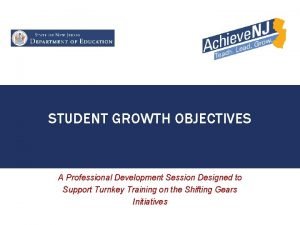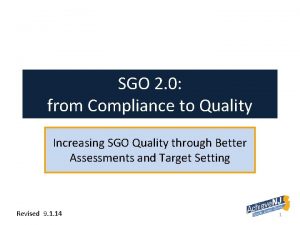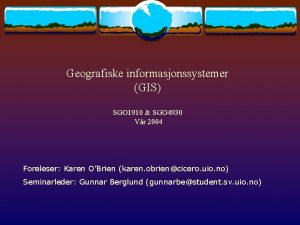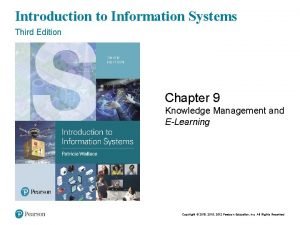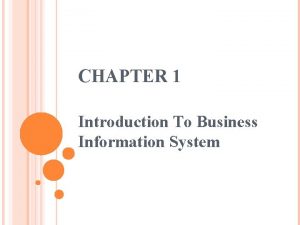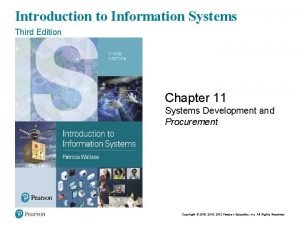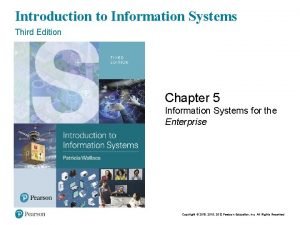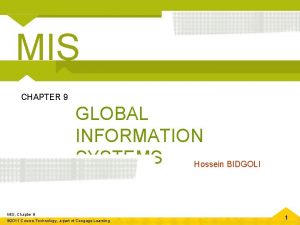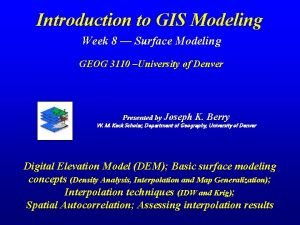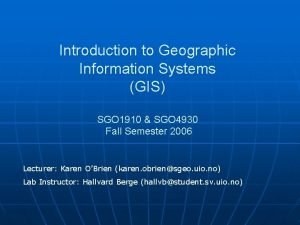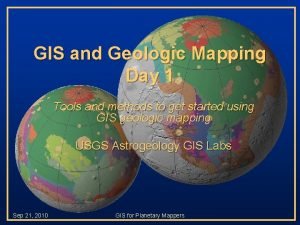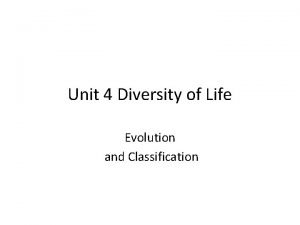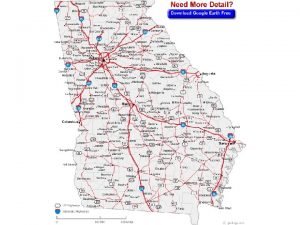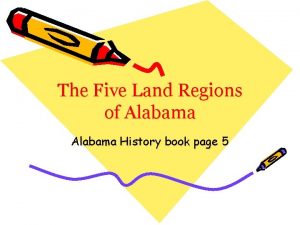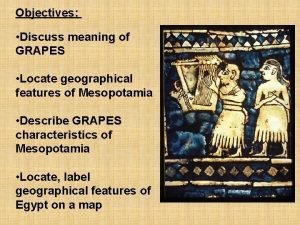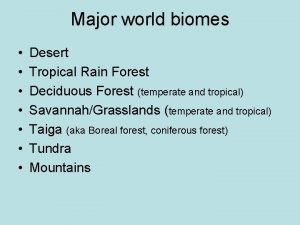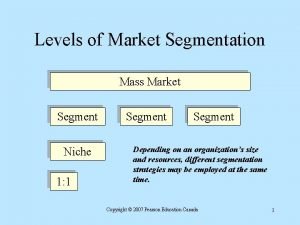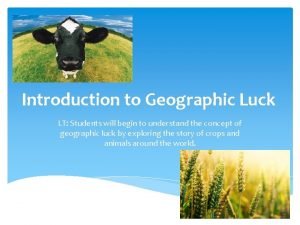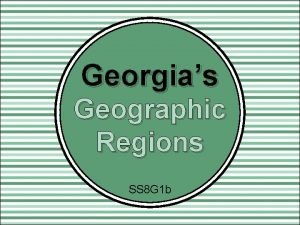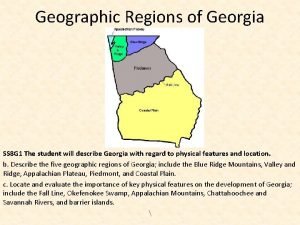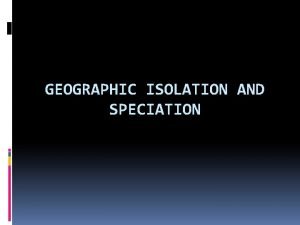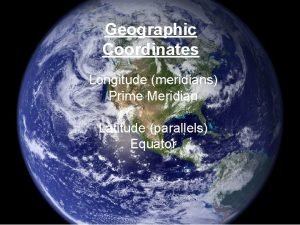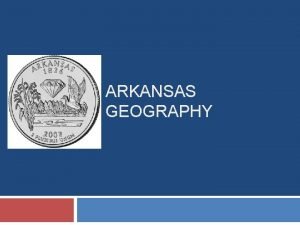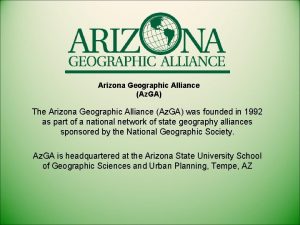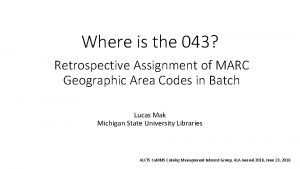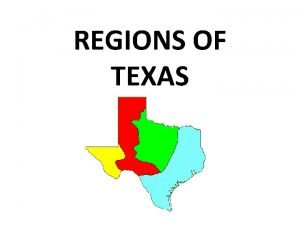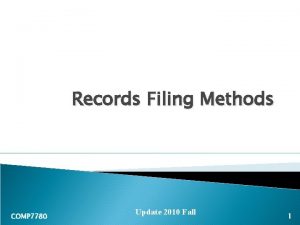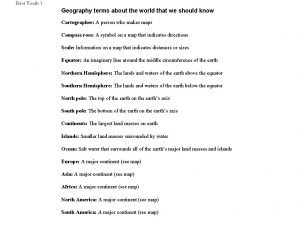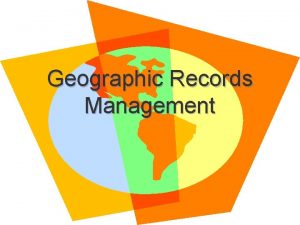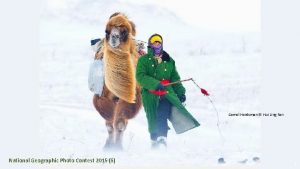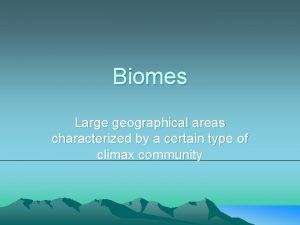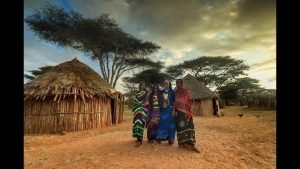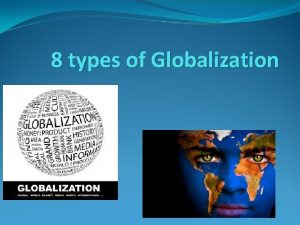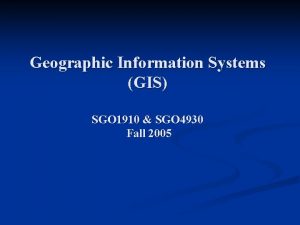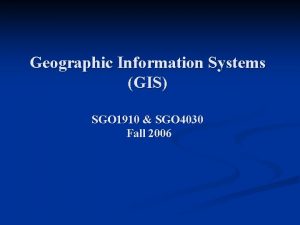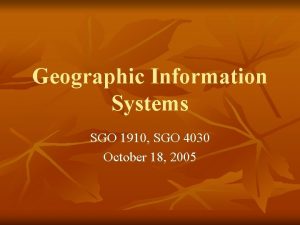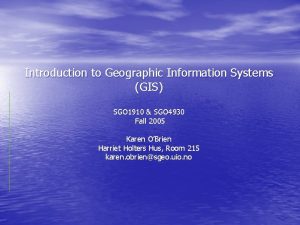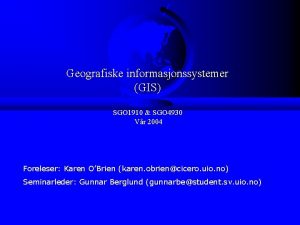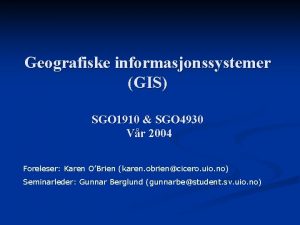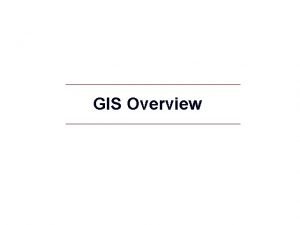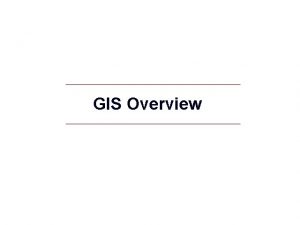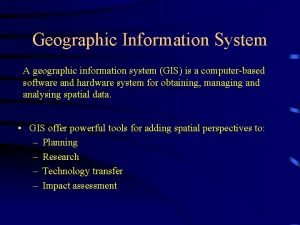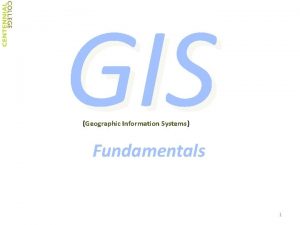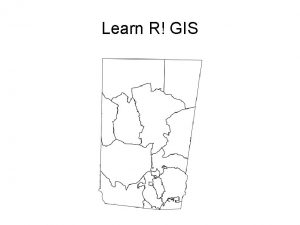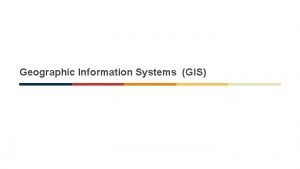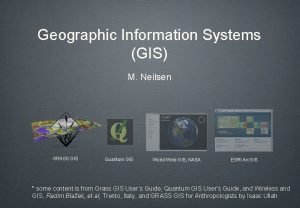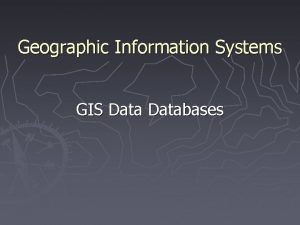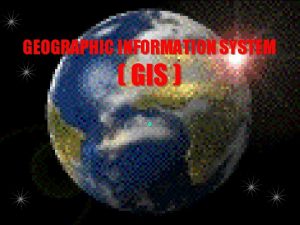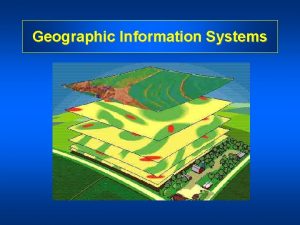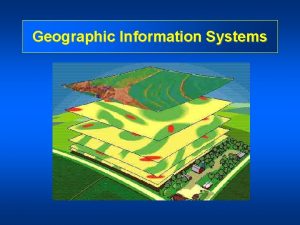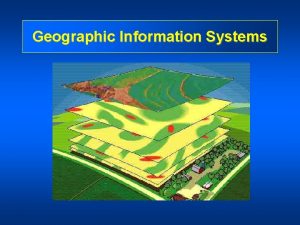Introduction to Geographic Information Systems GIS SGO 1910

























































- Slides: 57

Introduction to Geographic Information Systems (GIS) SGO 1910 & SGO 4930 Fall Semester 2006 Lecturer: Karen O’Brien (karen. obrien@sgeo. uio. no) Lab Instructor: Hallvard Berge (hallvb@student. sv. uio. no)

n http: //www. workingdogweb. com/Paleolithic. htm http: //www. srrb. nt. ca/projects/cmapping

http: //www. 1 uptravel. com/worldmaps/south-africa 9. html



Google Earth n n n n Offers maps and satellite images for complex or pinpointed regional searches. Fly from space to your neighborhood. Type in an address and zoom right in. Search for schools, parks, restaurants, and hotels. Get driving directions. Tilt and rotate the view to see 3 D terrain and buildings. Save and share your searches and favorites. Add your own annotations.



Course Objectives n n n To provide students with a basic understanding of geographic information science; To provide students with practical experience in using Arc. GIS software; To apply both theory and practice in a research project (”Oslo project”).

Readings: n n Longley, P. A. , Goodchild, M. F. , Maguire, D. J. , and D. W. Rhind. 2001. Geographic Information Systems and Science. Second Edition. Chichester: John Wiley and Sons, 517 pp. Chapters 1, 3, 4, 5, 6, 9, 10, 12, 14, 15, 18

Grading n n n 30% Two mid-term quizzes (Week 39 & Week 44) 30% Final Project 40% Final Exam

Lab Assignments n n n Submitted on your own home page Due dates: All labs must be completed before the final exam. Labs will not be graded, but they will be spot checked, and you are required to complete all labs (one will be excused)

GIS Labs n n n Arc. GIS 9. 0 (GIS) Excel (data base files) NVu (web pages) Adobe Photoshop (sizing maps and pictures) Win. Zip (decompressing files)

Mid-term quizzes n n n Each quiz has 25 questions Multiple choice, true-false questions based on readings and lectures 45 minutes to complete the quiz

Project Identify a problem or question to address related to Oslo; n Collect and edit data; n Use GIS to map and analyze data; n Present results in a written report. *(masters students may choose to write a paper relating GIS to a research theme) Due: December 15, 2006 n

Final Exam n n n December 1, 2006, 09. 00 -12. 00 (3 hours) Essays, short answer, multiple choice, true-false Based on lectures, readings, and labs

Questions n n Office hours by appointment Lab assistance: to be announced

Why take this course? n n GIS is a useful tool with a wide range of applications; GIS is a skill that is in demand, with a growing market; Geographers have numerous advantages related to GIS; GIS is challenging (but fun!)


What is a GIS? 1. 2. A computer system capable of holding and using data describing places on the earth’s surface. An organized collection of computer hardware, software, geographic data, and personnel designed to efficiently capture, store, update manipulate, analyze, and display all forms of geographically referenced information.

Geographic Information System n Organized collection of • Hardware • Software • Network • Data • People • Procedures Software People Data Network Procedures Hardware

”A GIS by any other name” n n n Land Information System Delivery Routing System Emergency Response System Disaster Planning System Crime Monitoring System Real Estate ”Homefinder” System




Why is GIS Important? n n n Provides a consistent framework for integrating spatial and other kinds of information within a single system (ideal for interdisciplinary work). Permits manipulation and display of geographical (digital) data in new ways. Makes connections between activities based on geographic location.

What can a GIS do? n n n Location (Where is it. . . ) Condition (What is it. . . ) Trend (What has changed. . . ) Pattern (What is the pattern. . . ) Routing (Which is the ’best’ way. . . ) Modeling (What if. . . )

A Brief History of GIS n n GIS’s origins lie in thematic cartography. Many planners used the method of map overlay using manual techniques. Manual map overlay as a method was first described comprehensively by Jacqueline Tyrwhitt in a 1950 planning textbook. Hc. Harg used blacked out transparent overlays for site selection in Design with Nature.

Map Overlay

A Brief History of GIS (cont. ) n n The 1960 s saw many new forms of geographic data and mapping software. Computer cartography developed the first basic GIS concepts during the late 1950 s and 1960 s. Linked software modules, rather than stand-alone programs, preceded GISs. The Harvard University ODYSSEY system was influential due to its topological arc-node (vector) data structure.

A Brief History of GIS (cont. ) n n GIS was significantly altered by (1) the PC and (2) the workstation. User Interface developments led to GIS's vastly improved ease of use during the 1990 s. During the 1990 s, new GIS software could better exploit more advanced hardware. So far in the 2000 s: • Internet becomes major deliver vehicle for GIS • More than 1 million active users of GIS • GIS is linking to other technologies (e. g. mobile phones, palmtops, etc. )


Late 1970 s http: //www. acme. com/jef/punch_car ds/


Interest in GIS is Rising n n n n n Applications via Internet Price reductions Greater awareness Improved ease of use Better technology Proliferation of data Commercial software packages Real applications Proven cost: benefit cases

Business of GIS n GIS industry is worth over $7 billion • Software • Data • Services • Publishing • Education

GISystems, GIScience and GIStudies n GISystems • Emphasis on technology and tools n GIScience • Fundamental issues raised by the use of GIS and related technologies n n n Spatial analysis Map projections Accuracy Scientific visualization GIStudies • Systematic study of the use of geographic information

Sources of Information on GIS n n The amount of information available about GIS can be overwhelming. Sources of GIS information include journals and magazines, books, professional societies, the World Wide Web, and conferences. GIS has Web Home pages, network conference groups, professional organizations, and user groups. Most colleges and universities now offer GIS classes in geography departments.

GIS Resources: Conferences

GIS Konferans: Oslo Plaza 1. -3. februar 2006 • Norsk ESRI brukerkonferanse 2007 Den 18. norske ESRI brukerkonferansen går av stabelen i februar 2006. Konferansen byr på en rekke foredrag, tekniske minikurs, bransjeseminar og sosiale aktiviteter. Vi ser frem til spennende dager sammen med deg! Påmelding og mer informasjon kommer senere. • Pris: 150 NOK ( dagsbesøk) See http: //www. geodata. no/

GIS Resources: Glossies

Major GIS-Only Journals n n n International Journal of Geographical Information Systems Geographical Systems Transactions in GIS Geo Info Systems GIS World

Specialty Journals n n n Business Geographics GIS Law GIS Asia/Pacific GIS World Report/CANADA GIS Europe

Regular GIS Papers n n n n Annals of the Association of American Geographers Cartographica Cartography and GIS Computer; Computers, Environment, and Urban Systems Computers and Geosciences IEEE Transactions on Computer Graphics and Applications Photogrammetric Engineering and Remote Sensing

Occasional GIS papers n n n n n Cartographic Perspectives Cartographica Journal of Cartography Geocarto International IEEE Geosciences International Journal of Remote Sensing Landscape Ecology Remote Sensing Review Mapping Science and Remote Sensing Infoworld

Popular Distribution Magazines n n n Business Geographics Geo Info Systems GIS Law GIS World GPS World GEODATA

Summary Geographic problems usually involve location. n GIS – A special class of information systems that keep track of events, activities and things, but also where these events, activities, or things happen or exist. n The difference between GIS and basic mapping and spreadsheet programs lies in its ability to handle spatial data. n


How do I use GIS? Global Environmental Change n Vulnerability, adaptive capacity, human security n GIS as a tool for assessing uneven outcomes; Who are the winners and losers from global change? n

GIS and Quantitative Analysis: Vulnerability to climate change and economic changes in Indian agriculture

Context n Agriculture in India • • • n 27 % GDP 700 million people more than 60 % is rainfed cultivation Both climate change and economic globalization are ongoing processes with uneven impacts. Indian agriculture will be confronted by both processes simultaneously, leading to changing patterns of vulnerability.

Main objectives n n n Assess vulnerability of agriculture to climate change in the context of economic changes Use GIS to identify highly vulnerable areas and social groups Interview farmers in highly vulnerable areas to understand how farmers are coping with climatic and economic changes

Methodology n n n GIS-based vulnerability profile Village-level case studies Integration of macro- and micro- scale analyses

Globalization vulnerability

Climate Change Vulnerability

Double Exposure: Areas that are Vulnerable to both Climate Change and Globalization

Case study approach n Questionnaire-based survey • • Economic status Agricultural practices Coping mechanisms Access to facilities (electricity, irrigation, health, education, loans, etc) • Participatory rural appraisals • Focus group discussions with small and marginal farmers • One-to-one meetings with village heads and district administrative officers
 Sgo examples for special education
Sgo examples for special education Drive daily instruction
Drive daily instruction How to calculate sgo score
How to calculate sgo score Sgo assessment examples
Sgo assessment examples Sake levels of quality
Sake levels of quality Sgo assessment examples
Sgo assessment examples Sgo polygon
Sgo polygon Tabel sgo
Tabel sgo Introduction to information systems 6th edition
Introduction to information systems 6th edition Fundamentals of information systems chapter 1
Fundamentals of information systems chapter 1 Introduction to information systems 3rd edition
Introduction to information systems 3rd edition Introduction to management information systems 5th edition
Introduction to management information systems 5th edition What is information
What is information Introduction to accounting information systems
Introduction to accounting information systems Introduction to information systems 3rd edition
Introduction to information systems 3rd edition Introduction to information systems 3rd edition
Introduction to information systems 3rd edition In a global information system (gis), high coordination:
In a global information system (gis), high coordination: Introduction to gis
Introduction to gis Introduction to gis
Introduction to gis Introduction to gis
Introduction to gis Coordinate
Coordinate Weathering national geographic
Weathering national geographic Evolution
Evolution Ga geographic regions
Ga geographic regions Product advertisements are advertisements that focus on
Product advertisements are advertisements that focus on Physiographic regions of alabama
Physiographic regions of alabama Temperate forest location
Temperate forest location There are _____ time zones on earth.
There are _____ time zones on earth. National geographic salem witch trials
National geographic salem witch trials Autzi ecommerce traders
Autzi ecommerce traders Language egypt
Language egypt Arkansas river valley resources
Arkansas river valley resources National geographic
National geographic Geographic demographic and psychographic
Geographic demographic and psychographic Deforestization
Deforestization Mass segmentation
Mass segmentation Geographic luck
Geographic luck Georgia geographic region
Georgia geographic region Geographic regions of georgia
Geographic regions of georgia Which of georgia's geographic regions is the smallest?
Which of georgia's geographic regions is the smallest? Geographic isolation
Geographic isolation Types of geographic data
Types of geographic data Latitudinal geographic zones
Latitudinal geographic zones Copyright
Copyright Geographic regions of arkansas
Geographic regions of arkansas Az geographic alliance
Az geographic alliance Geographic features of greece
Geographic features of greece A to z place name
A to z place name Regions of tx
Regions of tx General alphabetic section of the numeric file
General alphabetic section of the numeric file Arizona geographic alliance europe map
Arizona geographic alliance europe map Geographic records management
Geographic records management Geographic features of australia
Geographic features of australia South carolina regions
South carolina regions National geographic camel photo
National geographic camel photo A large geographic area characterized
A large geographic area characterized Thorsten hanewald
Thorsten hanewald Ecological globalization
Ecological globalization
